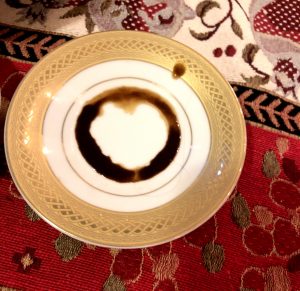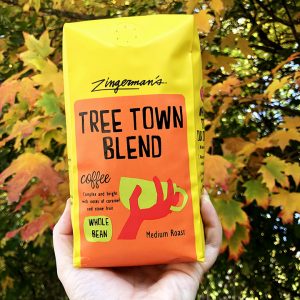Zingerman’s Coffee for ALL.
Introducing a totally approachable new line of joe from Zingerman’s Coffee Company.
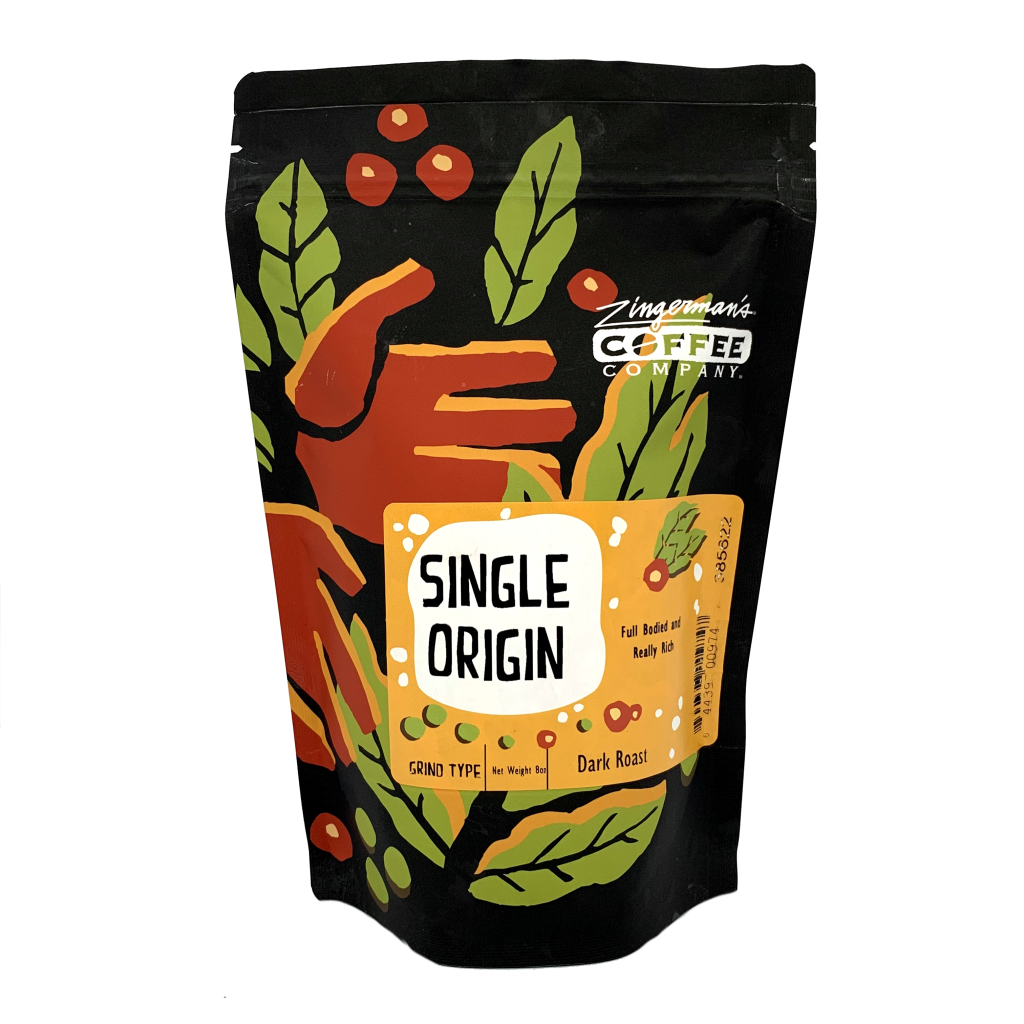
Zingerman’s Coffee Company is excited to present a new line of products to round out our presence in the specialty coffee category. The Crowd Pleasers line was conceived to be an approachable introduction to specialty coffee featuring beans with distinctive, balanced flavors.
MSRP: $7.99-$9.99
- Eye-popping packaging
- Full range of roasts
- Includes blends, a single-origin, and an actually-delicious decaf
- Re-sealable bag with valve
- Stand-up, matte black pouch
- Zingerman’s great taste; approachable price point
Coming SUPER soon!
Have questions? Interested in carrying this product?
Feel free to reach out to us at [email protected]!
DRIPPIN’ IN FRESHNESS: How to get the most out of your coffee
When we stand in our kitchens, bleary-eyed with coffee pot in hand, it’s unlikely that we’re reflecting on how this beverage—which we ritualistically consume—is made. Perfectly understandable, given that most of us don’t have any synapses firing until after the stuff hits our lips.
So, right now, in this very moment, we’d like to invite you to reflect on the laborious process and lengthy journey that those tasty, life-giving beans endure. From seedlings tended to in a nursery, to a ripe red cherries expertly plucked and processed, carefully stored and shipped across oceans. The many hands, many moons, and many miles involved to get the coffee stateside.
And that’s just the start! A coffee guru lovingly roasts those green guys into something delightfully drinkable, and packages them just so to preserve the flavor as long as possible. Then, finally, it’s yours.
Perhaps, like me, you find the long, laborious journey that coffee takes to get to you humbling, and want to introduce care and expertise to your role in it. Or, you simply have an interest in knowing the inside scoop (pun intended) on keeping and preparing your coffee so it’s as fresh and tasty as can be! Either way, read on.
FRESH, WHOLE BEANS
As you may have gleaned, freshness starts with your friendly neighborhood roaster (hey, that’s us!). Coffee is a perishable good, so, fresh coffee equals good coffee. Coffee flavor peaks mere days after being roasted, and definitely should be consumed within a month of its roast date. Does the coffee you buy have a “best by” date as opposed to a “roasted on” date? Buyer beware! This can be totally arbitrary and result in purchasing a coffee that’s stale—lacking the aroma and depth of its formerly fresh self.
PACKAGING
In addition to the roasting, how a coffee is packaged makes a huge difference. If your coffee is vacuum-sealed, it was likely aged before being packaged – this is because coffee releases CO2 gas after being roasted (in a vacuum-sealed bag, well, it would go ka-boom!). One-way valve-sealed packaging is the way to go, as it lets gas from fresh coffee out, but no oxygen in.
GRINDING
And what about the beans themselves? Do you buy them pre-ground or whole? Pre-ground coffee loses its freshness much faster, given that more surface area is exposed to oxygen and moisture, elements that are none-too-kind to coffee. Some coffee folk say that pre-ground coffee starts losing its freshness within 30 minutes of being ground! Compare that to whole bean, which will stay fresh for nearly a month.
Your local roaster will likely grind your coffee beans for you if you don’t want to invest in a home grinder. Grinding your beans at home, however, is not only a great way to tell if your coffee is fresh or not (if the coffee aroma fills the kitchen as you grind the coffee, it’s fresh. If not, it’s stale!), but it allows for you to properly calibrate the fineness of the grind needed for your particular brewing method(s), and to get the freshest possible coffee. We recommend getting a grinder that uses burrs rather than blades, because burr grinding produces more uniform coffee particles, and improves the quality of flavor extraction you get from your grounds when you brew.
Here in the café, we sell the Rocky Rancilio Grinder, which, unlike many home grinders has replaceable burrs. It’s ideal for espresso, but can be set to accommodate a full range of brewing methods. We also carry the Bodum Bistro Grinder which, conversely, is not ideal for espresso but accommodates all other brewing methods. Furthermore, this grinder crushes beans between stainless steel conical burrs rather than slicing them. This preserves the bean’s intrinsic flavor and aroma while providing a consistent grind.
STORING
Whether you buy pre-ground or whole bean, how you store your coffee is an important aspect to maintaining freshness as well. Again, light, oxygen, and moisture are enemies of coffee! If you can’t keep your coffee stored in a pantry, make sure it’s in an opaque container. And, regardless, air-tight storage is ideal. We also don’t recommend freezing your coffee. Thawing and refreezing coffee can cause freezer burn, affecting flavor. If you have a lot of coffee on-hand and and want to keep vibrant for as long as you can, make sure to divide it into pre-portioned bags before putting it away in the freezer. This way, you’re taking the coffee out of the freezer just once!
CLEANING
Finally, when is the last time you cleaned your coffee gear? Coffee oils can build up on your equipment, and minerals from hard water can form scale deposits that can affect how your equipment functions. We carry coffee equipment cleaning products in our cafe. If you are curious about what cleaning your gear needs, come chat with us!
We know you love (or at least need) your morning cup o’ joe, and would like to invite you to consider the preparation and storing of the stuff to be as much a part of your daily ritual as brewing and drinking it. Our coffee is a labor of love from around the world, and its journey ends in your hands!
Uganda Rwenzori Coffee
New Coffee of the Month from East Africa
Ari Weinzweig, CEO & Co-Founder of Zingerman’s
| While so much has been turned topsy turvy over the last year, one thing that has provided comfort and consistency throughout has been the quality of the beans at the Coffee Company. In fact, I would venture to say, through all the ups and down of the last twelve months, the coffee has actually gotten better. The April Coffee of the Month—from the mountains of southwest Uganda—is pretty darned amazing. Coffee originates to the north of Uganda in Ethiopia—it’s grown wild there for far longer than humans have been consuming it. Coffee is a relatively recent arrival in Uganda, essentially part of the same Industrial Age push to identify export crops that brought coffee to Central and South America. Today Uganda produces about 4% of the world’s coffee, tiny by the standards of say Brazil, but about four times where it was in the early years of the 20th century. |
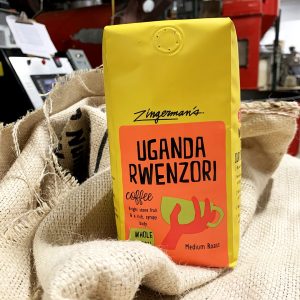
The Rwenzori mountains where these beans are grown are near the country’s western border with the Democratic Republic of the Congo, and to the north of the Rwandan frontier. You’ll see the mountains on the map about halfway between Lake Stanley and Lake Edward, to the west of Lake Victoria (Africa’s largest lake). The mountains range up to 16,000 feet, and the coffee is grown in the lower (but still high) altitudes in the shade of banana trees, which protect the delicate coffee cherries from “burning” in the sun. The coffee is a “natural process”—dried in the sun—which concentrates the sweetness and the flavor in a way that I love.
Steve Mangigian, long time managing partner at the Coffee Company, says, “We immediately loved the fruitiness of this coffee. That’s what caught my attention. It exemplifies the characteristics of great East African coffee.” Juicy peach notes (speaking of which, the Peach Truck is coming to town this summer), maybe you could say even a bit of nectarine. It’s nicely chocolatey and terrifically tasty. It’s very good straight out of the Fetco pots at the Coffee Company, Roadhouse, and Deli. If you’re at the Coffee Company it is particularly chocolatey in a pourover and delicately delicious brewed in a syphon pot. Add a piece of the Bakehouse’s marvelous Mandelbread or a Big O Oatmeal Raisin cookie and bring a bit of beauty to your day!
Excerpt from Ari’s weekly Top 5 E-Newsletter. To stay in-the-know about things that Ari is excited about in the Zingerman’s family, sign up here!
Erlita’s Lot Coffee from Peru
Grown, harvested, sold, and shipped by women
Ari Weinzweig, CEO & Co-Founder of Zingerman’s
Back in 2004, Isabel Uriarte Latorre co-founded Café Femenino, an organization dedicated to empowering women on the front lines of the coffee industry. From the get-go, she built the business to support women in the work world financially, spiritually and socially. The project allows women to produce high-quality coffee and get paid commensurately—they’re not stuck bargaining with aggressive buying agents out on the marketplace. And, as per what I wrote above, to boost the energy of women who had generally been left out, ignored, or even abused, and help them reclaim the full lives to which they have always been entitled. The folks at Café Femenino share that:
“Women in remote and rural coffee communities face a host of challenges that keep them trapped in poverty. Many of these isolated women live in male-dominated societies and have very little financial control or decision-making power. 464 women farmers in northern Peru decided to change this dynamic by separating their coffee production from the men’s. In that moment, for the first time, this group of women created their own product and income… to support social justice and empowerment for women coffee producers worldwide.”
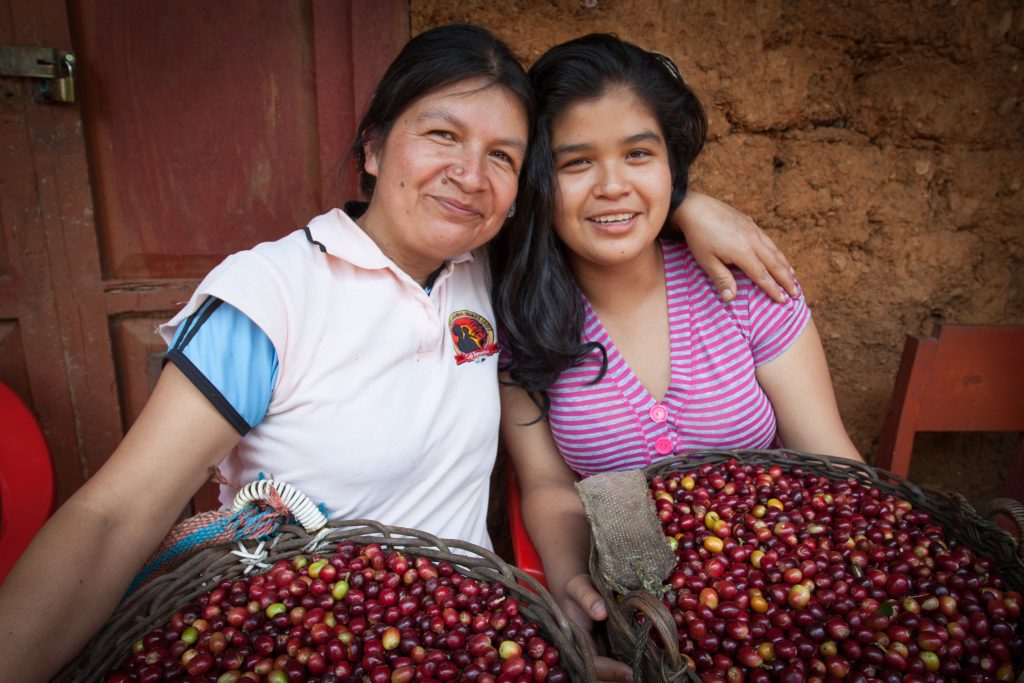
Coffee production came to Peru in the 1700s. After two centuries, the heirloom typica variety still comprises 60 percent of the country’s exports. There are more than 110,000 coffee growers in Peru, most of whom are indigenous to these landscapes and speak Spanish only as a second language. The average land-holding farmer lives on less than three hectares, hours from the comforts of electricity and running water. Erlita Baca Arce’s farm is near the Peruvian village of Nueva York, a small coffee community in the Amazonas region of northern Peru, east of the Andes Mountains, at 5700 to 6500 feet above sea level—an ideal altitude for high-quality Arabica coffee trees. Erlita has been part of the project since its inception and now serves as the treasurer of the coop, and as she explains:
“Café Femenino has given me many opportunities to improve the quality of my coffee and the quality of life for my family. I invest the premium I earn in improving our community, providing education for our daughters, and improving the food that we feed our families. Café Femenino has been wonderful in improving the self-esteem and empowerment of the women in our community.“
Erlita is not alone in her positive comments. Every article I’ve read about Café Femenino details outstanding results: increased local recognition of the work the women are doing, both in the fields and on the home front; a reduction in abuse (physical, emotional, and sexual); an increase in income; more men are participating in child care and housework; and upswing in school attendance among local girls. In addition, because the female coffee producers in the area now have the potential to get a better price for their coffee, many men are signing the deeds of their land over to their wives so their coffee will be eligible for Café Femenino designation.
While dignity, meaningful work, and good coffee are always in season, National Women’s History Month is a particularly good time to take notice of Erlita’s Lot. The history of the event goes back over a century to the years before WWI and the Spanish flu, to the end of February 1909, when “National Women’s Day” was sponsored by the Socialist Party of America. By March of 1911, International Women’s Day (IWD) was marked by over a million people demanding the right to vote for women, workplace safety, equitable pay, etc. Six years later, on March 8, 1917 in the Russian capital of Petrograd, women workers took to the streets for National Women’s Day, demonstrating en masse in an event that unexpectedly turned into the Russian Revolution. The Tsar abdicated a week later, on March 15. Leon Trotsky wrote, “March 8th was International Women’s Day, and meetings and actions were foreseen. But we did not imagine that this ‘Women’s Day’ would inaugurate the revolution.”
The Erlita’s Lot coffee is as great as the story behind it. Smooth, a bit of dark chocolate, maybe even like a piece of toasted Country Miche bread from the Bakehouse. The coffee has a surprisingly clean finish and modestly full mouthfeel. All the brew methods have been good, but I’m stuck on the smoothest flavor of the bunch, which I found to be Chemex (the syphon pot and the Clever brewing weren’t far behind). Sip some of this great new coffee and nibble on a Bakehouse oatmeal raisin cookie. Erlita’s Lot is available at the Coffee Company, Next Door at the Deli, and at the Roadhouse. Sit, and appreciate the morning as we move into spring. And because I seem to have a proclivity of late for Peruvian poets, here’s a short one that seems right for the moment from surrealist writer Blanca Varela:
it’s seven in the morning
it’s the perfect time to start
dreaming
the coffee becomes eternal
and the sun eternal
if you don’t move
Excerpt from Ari’s weekly Top 5 E-Newsletter. To stay in-the-know about things that Ari is excited about in the Zingerman’s family, sign up here!
Zingerman’s Coffee Company – February Dine-In Update
To our wonderful guests,
February 1 is here, and we want to share with you our updated guidelines here at Zingerman’s Coffee Company, given the recent direction from the State of Michigan to allow restaurants to reopen dine-in service:
- Indoor seating will be available for to enjoy – for a maximum of 30 minutes – from 7am-4pm daily.
- As required by the Michigan Department of Health and Human Services (MDHHS), tables will be 6 feet apart, no more than 6 guests are allowed at a table, and we will have limited seating capacity.
- You are required to wear a mask unless actively eating or drinking, and we are required to collect your contact information for contact tracing.
- Due to limited seating, it is available on a first come, first served basis.
MDHHS very clearly reminds us that indoor dining remains high risk, and asks us all to consider reducing our risk by choosing takeout, delivery, or outdoor dining.
We hope you will continue to:
- Order online for contact-free, in-store pick-up
- Swing by our cafe and consider taking your coffee to go
- Order for home delivery via GrubHub
- Stock up and stay safe with our 5# bags of coffee, delivered nationwide!
We are beyond grateful for your support and patronage in these difficult times. We’ll keep you posted on any changes as soon as we can!
Warmly,
Zingerman’s Coffee Company team
New Single-Origin Coffee from Guatemala
A beautiful brew from the coffee-growing “star” of Central America
Ari Weinzweig, CEO & Co-Founder of Zingerman’s
Guatemala has an ancient and highly esteemed history that goes back to the advanced Mayan civilization dating to about 2000 BC. Coffee is a relatively recent arrival—serious commercial planting started in the middle of the 19th century, primarily with German immigrant planters, about a decade after the demise of a nation-state that almost no one around these parts will have heard of. The Federal Republic of Central America was founded in 1823—less that 50 years after the Declaration of Independence of the United States. The Federal Republic of Central America included what’s now Nicaragua, Costa Rica, El Salvador, Honduras, Chiapas and Guatemala. It started with much the same spirit as the U.S., as a democratic nation state, but came apart in the course of its own Civil War in 1938.
A century and a half down the road of history, Guatemala consistently produces some of the most flavorful coffee one can find anywhere. And some of the best of the best comes from an estate in the northern part of the country called “Los Dos Socios.” Here’s what the crew at the Coffee Company said:
The name was selected by Don Concepcion Villatoro Matias to refer to “the two associates” involved in producing coffee at his farm: himself and God. His approach has been a simple one since purchasing the farm in 1990: plant bourbon and caturra varietals under shade trees, tend them well, and keep parcels separated to maintain unique lots. His farm in Huehuetenango is up high with a view of the mountains, making for a lovely place to live and work. Huehuetenango is one of Guatemala’s prized coffee-growing regions, and with coffees as vibrant and exciting as this one, it’s easy to see why.
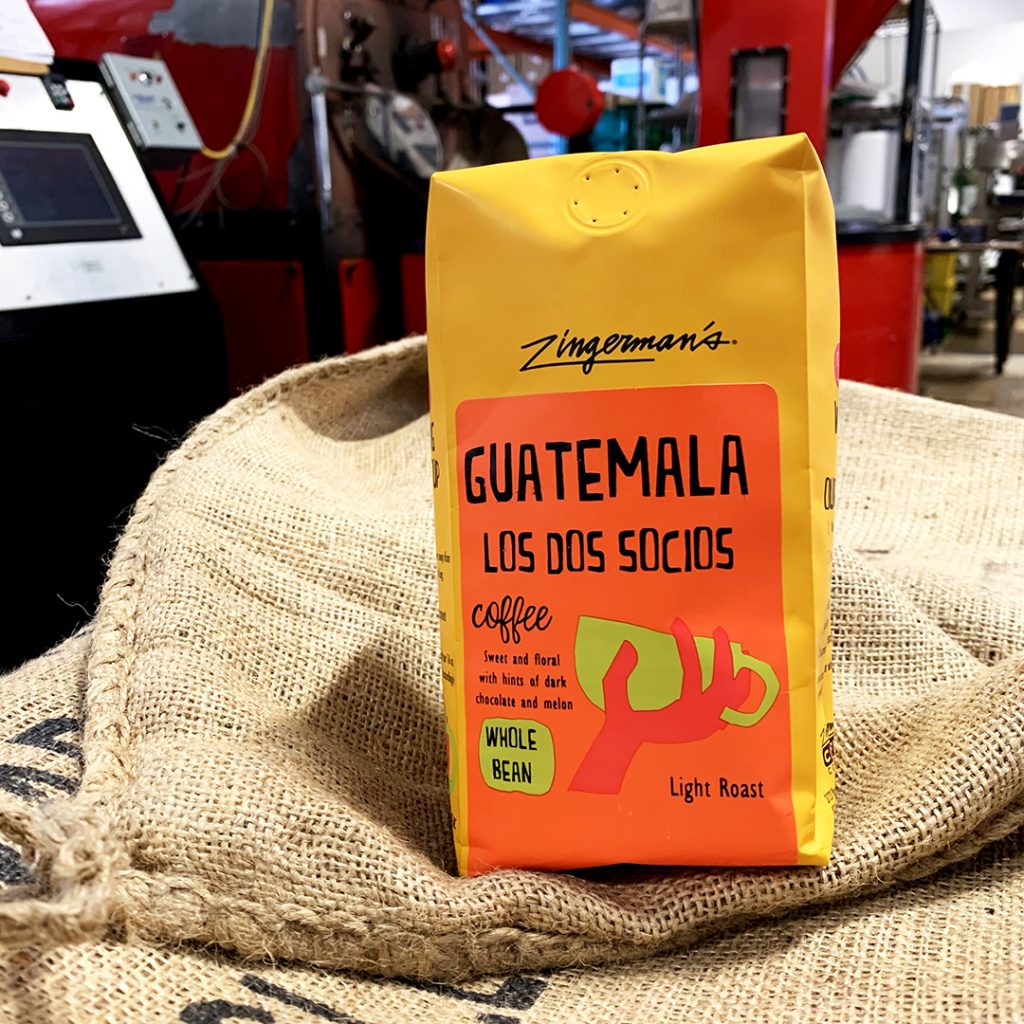
The flavor profile we’re getting out of Los Dos Socios is a thing of beauty: juicy blackberry notes, some really rich caramel smoothness, and a zing of bright papaya all working together. It reminds us of the coffee cherries we snacked on while visiting farms in Guatemala last year—the juicy, sweet, and tangy combination of flavors is a great way to describe the taste of the fruit surrounding a coffee bean. As long days of farm visits wore on, it was neat to see farmers picking a few cherries and snacking – even before it’s processed, roasted, and brewed, coffee can provide small moments to enjoy. We hope you appreciate all the hard work that went into these beans, and that you enjoy your brews of Los Dos Socios all the more for it!
I’ve been loving the coffee for the last few weeks. It’s got… a wonderful combination of depth and delicacy, substance and subtlety, softness and strength. It is, as per what I wrote above about vision, a positive and sustainable testament to the work of Don Concepcion and his team. There is something special, hard to pin down, that makes it so eminently calming, comforting and enjoyable. It has what Christopher Alexander wrote in The Timeless Way of Building: “In our lives, this quality without a name is the most precious thing we ever have.”
Come by the Coffee Company, the Deli, or Roadhouse and grab a bag of beans or a cup to go. Or let us ship—you won’t see it on the zingermans.com site, but email [email protected] and let us know what you’d like. Better still, sign up for a Mail Order Coffee Subscription!
P.S. If you’re at the Roadshow getting coffee, say hi to Celia who is from Guatemala, and proudly thanked me for carrying “her coffee.” I thank her for her great work and for bringing our vision and values alive every day in such beautiful ways!
Excerpt from Ari’s weekly Top 5 E-Newsletter. To stay in-the-know about things that Ari is excited about in the Zingerman’s family, sign up here!
Holiday Blend from the Coffee Company
A beautiful brew that can turn any day into a holiday!
Ari Weinzweig, CEO & Co-Founder of Zingerman’s
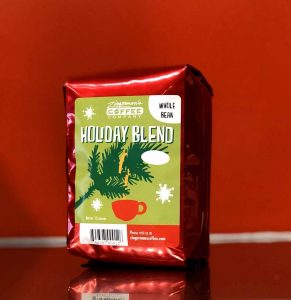
If you’re thinking about what to drink when you dive into a nice piece of pecan pie or with a toasted slice of Cranberry Pecan bread for breakfast, this seasonal brew from the Coffee Company could be just the trick.
We’ve been designing and offering an annual Holiday Blend for over a decade now—each year is a bit different to honor what’s best on the “green bean” market and the spirit of that particular season. This year, Steve (our longtime managing partner, and part of that Partners Group consensus), Matthew (the former staff partner I quoted above), and Chris (our roastmaster) have put together a trio of terrific beans for the blend.
Colombian ASPROBALBOA—From a coop of family farms near Balboa. It brings great high notes with hints of citrus and caramel to the blend.
Brazilian Espresso Blend #1—Sustainably grown, carefully processed, with big, well-rounded flavor.
Costa Rica—From the Hacienda Miramonte. It brings subtle sweetness and a rich, velvety body.
Each bean brings its own distinct flavor, and in the cup they come to a nice consensus on a single great flavor! Steve says, “The collection of coffees is representative of some of the best relationships we have—we know ALL of these producers personally and they are some of the longest standing relationships we have.” It would be safe to say that this year’s Holiday Blend is a beautiful homage to the support they have given us through the years! It’s got a full flavor, and a touch of nice astringency. It reminds me of the dark chocolate from the Dominican Republic that we’re getting from 9th & Larkin. True to the spirit of the 2020 season, it’s a bit darker than last year’s blend, but with notable hints of brightness and subtle floral notes. And, somehow, it seems to leave me feeling a bit more optimistic after I sip it.
Want to sign up for regular shipments of Zingerman’s Coffee? Check out Zingerman’s Coffee Club and the Zingerman’s Coffee Subscription at zingermans.com.
Available at the Coffee Company, Deli, Roadhouse, and Mail Order!
Excerpt from Ari’s weekly Top 5 E-Newsletter. To stay in-the-know about things that Ari is excited about in the Zingerman’s family, sign up here!
Coffee’s Sixth Sense 🔮
A History of Fortune Telling and Family Tradition
By Michelle Abbey, Zingerman’s Coffee Company
The year is 1974. The setting is one startlingly bygone, culturally: a family living room, thick with cigarette smoke. Zingerman’s Coffee Company’s Managing Partner, Steve Mangigian, is 10 years old. After a meal together, Armenian coffee is not only served, but read. Steve recalls the female elders of his family flipping the contents of their cups onto saucers, scouring the grounds for images and their associated fortunes to emerge.
This is the story Steve consistently tells on his tours, during our “What is your first memory of coffee?” group icebreaker. “My parents needed a pot of Folgers to wake up.” is a common answer – I have yet to hear a guest share Steve’s experiences with family divination. He lights up; it’s a beloved childhood memory.
His experience while treasured is not unique. In fact, Steve isn’t the sole Armenian here in the small family of Zingerman’s Coffee Company! We’ve had a handful of Armenians come and go, and our Purchasing Manager, Laura, has Armenian roots.
“…She said it was extremely creepy and really hated the whole thing!”
The tradition in her family is remembered differently: “My mom talked about the tea leaf readings when she was a kid. This would have been the 1930’s. She remembers all the old Armenian ladies sitting in a circle bending over these cups and telling fortunes – they would tip them over into the saucers and read the leaves. She said it was extremely creepy and really hated the whole thing!”
The practice Steve and Laura describe in their families is called Tasseography: a divination or fortune-telling method that interprets patterns in tea leaves, coffee grounds, or wine sediments. The terms derive from the French word tasse (cup), which in turn derives from the Arabic loan-word into French tassa, and the Greek suffixes -graph (writing), -logy (study of), and -mancy (divination).
The practices’ origins can be traced back to medieval Europe. Fortune tellers read molten substances such as wax or lead. The method evolved into reading patterns of tea leaves after Dutch merchants introduced tea to Europe via trade routes to China. The tradition of coffee cup reading specifically is believed to have started in the 16th century when coffee made its way to the Ottoman Empire and the Middle East. The cultivation and distribution of coffee started in Ethiopia and moved from Yemen to the Arab trade and then to the Ottoman Empire. Armenians then popularized coffee in Europe.
Turkish coffee reading is very popular in Turkey and Greece. You can also find it in Russia and Eastern Europe, as well as Baltic and Middle Eastern countries.
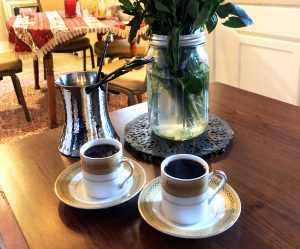
A traditional Ibric (kettle) and Armenian coffee cups. Note how the sides of the coffee cup do not slope down – this is necessary for proper grounds reading.
This tradition has gone by the wayside for some families, but the Mangigians are keeping it alive in their brood. Steve’s daughter, Bethanie, has taken over the tradition – but took her own route to get there.
“I actually wasn’t introduced to Armenian fortune-telling within my family, I wasn’t around it a lot as a kid.
“‘…’I see three men in your cup, encircling you.’ It was dead on, I had three orbiting at that time!”
I started doing this when I lived in New York. I was in college and took a course in Armenian history. I was first captivated by cup reading sitting in an ancient Armenian library. My professor did my first reading for me, it was startling and thrilling. She said, ‘I see three men in your cup, encircling you.’ It was dead on, I had three orbiting at that time! Should we include that?” she laughs.
Bethanie studied and lived abroad in the familial homeland of Armenia, with a host family. She got practice pulling cups with them, a family of artists.
“In their home and in the country itself, I was surrounded by beautiful imagery and architecture. There were beautiful symbols everywhere to inspire interpretations.”
It’s not just the cultural connection and experiences which draws Bethanie to cup reading.
“My mom uses the word ‘Kezba’, to describe this sixth sense that we have. And I work closely with people as a social worker and therapist. When you read cups, you have a connection with that person. I love this medium as a way to develop relationships with people. You cut through small talk to who they are, what their journey is. I can guide the reading, but people come up with their own interpretations, which is fascinating insight.”
Her eeriest experience?
“I did a cup reading at a party for a guy I had met just a week prior. We ended up dating later on, and the symbols I saw in his reading ALL appeared throughout our relationship. A chameleon was one symbol – it ended up being way too telling! This is why I prefer to read for strangers. Reading for friends can hit too close to home. You have to be prepared for what the cup says.”
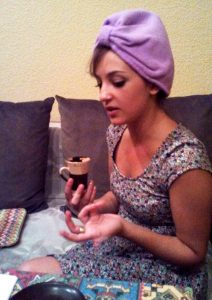
Bethanie hosts an Armenian Christmas party every year on January 6th, at her home in New Orleans. Her party favor giveaway is a drawing for someone to get a cup reading.
How do you read coffee, anyway? Simply drink your Armenian-style coffee in white china with no inside pattern or decoration. Shapes and patterns inside the coffee cup and on the saucer need to be visible for reading. After drinking most of the liquid in the coffee, cover the cup with the upside-down saucer and swirl three times. You wait for the grounds to fall from the bottom of the cup. This is why it is important to use the Armenian style espresso cup which is not rounded on the sides. The grounds fall down the sides of the espresso cup and dry at the bottom.
Put it down and allow a few minutes for the coffee to settle. Though it has some universally agreed rules, coffee cup reading is a very personal experience based upon on the “sixth sense”.
The type of coffee you use doesn’t really matter, just make sure it’s ground even finer than espresso and prepared, well, however your grandmother taught you to!
STEVE’S RECIPE:
- 8g coffee (Grind setting: 1 – finer than espresso, should feel like powder)
- 80g cold water
- 6g sugar
- 1 pinch of fresh ground cardamom OR
- 1 drop of rosewater
DIRECTIONS:
- Combine ingredients
- Bring to a boil and immediately
- Remove from heat
- Pour slowly to minimize the quantity of grounds in cup
Bethanie says this practice feels more precious in these times. “There’s a war against this small country [Armenia]. Holding onto these traditions feels even more important now. There are a lot of people I’m thinking about and worried about there right now.
“You may lose territory, but you can hang onto your culture.”
She wishes she could have been at the table with her Dad when her great aunt was telling fortunes. “It goes to show that these things need to be explicitly passed on, or you may lose them. You may lose territory, but you can hang onto your culture.”
Check out tasseography symbolism and best practices:
- https://coffeecupreadingsonline.com/divine-meanings-of-coffee-shapes/
- http://www.turkishstylegroundcoffee.com/turkish-coffee-reading/
—-
SOURCES:
- https://en.wikipedia.org/wiki/Tasseography
- https://coffeecupreadingsonline.com/divine-meanings-of-coffee-shapes/
- http://asbarez.com/174421/the-art-of-coffee-cup-reading-lives-on-through-a-new-generation/
- http://folklore.usc.edu/armenian-coffee-readings-ritual/
- http://www.digitaljournal.com/blog/16194
- http://elegantserenity.com/tasseography-art-tea-leaf-reading-future/
- http://www.turkishstylegroundcoffee.com/turkish-coffee-reading/
Tree Town Blend Coffee Beans
A fantastically flavorful cup of coffee that does the town proud
Ari Weinzweig, CEO & Co-Founder of Zingerman’s
Looking for a good coffee to perk up your mornings this month? Something to mark the start of September, welcome autumn, and sip while you watch the leaves start to change color? The 2020 release of our annual, early-autumn Tree Town Blend would be a particularly terrific way to do it. While the temperatures and the leaves slowly but surely start to fall, Tree Town is on the way up. Steve Mangigian, the Coffee Company’s managing partner, and I both agree—this year’s blend is better than ever!
Why “Tree Town”? Ann Arbor was founded in 1824, named for the wives of the village’s founders, both named Ann, and the stands of burr oak trees. That fall the U.S. held its 10th election for President. Voting lasted five weeks, from late October through December 1. No candidate won a majority of the votes and the election was turned over to Congress, where John Quincy Adams was elected. The “Tree Town” moniker derived over the years from the high volume of trees in the city. Until the arrival of Europeans, most of this part of the world—originally home to the Ojibwe people—was fully forested. But one of the first acts Europeans often engaged in was to take down large numbers of trees for timber, and then to plow virgin lands in order to farm—most of the city’s original trees were clear cut in the second half the 19th century to use for building here and for sale back east. Fortunately, early in the next century—around the time that Rocco Disderide built what’s now the Deli’s building back in 1902—the city embarked on a reforestation program. Given the positive impact that all those trees have on the aesthetics and ecology of the town, it seems that all of us who live here now ought to give those who led that project a big round of appreciation. The Tree Town blend is a celebration of that beauty.
Like the town for which it’s named, the Tree Town Blend is wonderfully well-rounded. And, as is true for Ann Arbor, its personality features contributions from caring sources from around the world—in this case, coffee beans Brazil, Guatemala, and Tanzania. The base is the Daterra espresso blend we get from the Pascoal family in Brazil. To that we’re adding coffee from a wonderful “crop to cup” lot we took possession of last month from Tanzania. And the whole thing is rounded out with some of that great Guatemala Esperanza (read more here…scroll down).
The result is a seriously tasty cup of coffee with a clean base of chocolate and caramel. It’s kind of cocoa-y, a bit nutty, remarkably smooth, and complex in a way that hints at dark plums. I’ve tried the Tree Town blend in all the brew methods at the Coffee Company and all have been pretty terrific. The Clever brewing was my favorite, but test them out and see what you like. You can drink a lot of it. As Steve says, “It’s not overpowering, and you could sip it long and slow all day. I love it.”
The Tree Town Blend is available at the Coffee Company on Plaza Drive, at the Deli, and at the Roadhouse (come sit outside at any or all of them and sip away)! Or ship some of this very special coffee to anyone who would appreciate a little taste of Ann Arbor!
Excerpt from Ari’s weekly Top 5 E-Newsletter. To stay in-the-know about things that Ari is excited about in the Zingerman’s family, sign up here!


